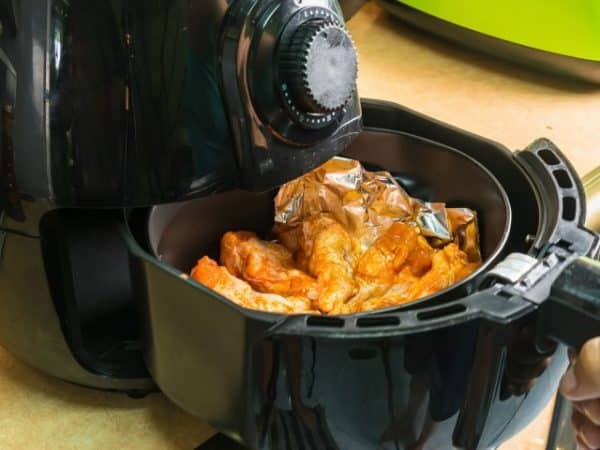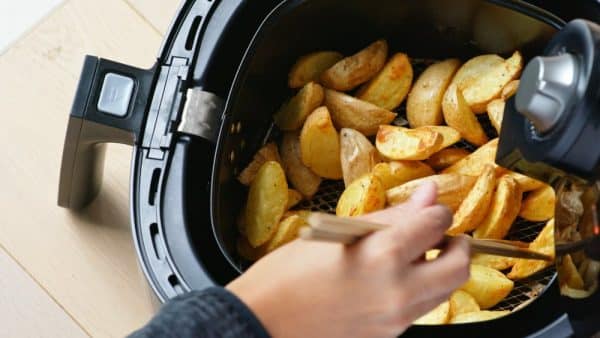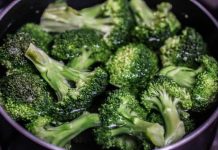Are you tired of eating dry and overcooked food every time you use your air fryer? Well, fret not!
In this article, we will explore some simple yet effective tips and techniques that will help you prevent overcooking food in an air fryer.
From adjusting the cooking time and temperature to using the right amount of oil, we’ve got you covered.
So, say goodbye to burnt meals and hello to perfectly crispy and delicious dishes with these helpful suggestions.
Choose the Right Cooking Temperature
Understand the Temperature Settings
When using an air fryer, it is essential to understand and choose the proper cooking temperature for your food. Most air fryers have temperature settings ranging from 180°C (350°F) to 200°C (400°F).
These temperature settings allow you to cook various foods, but knowing which temperature works best for each dish is essential.
Different foods require different cooking temperatures to achieve the perfect balance between crispiness and tenderness.
For example, delicate foods like fish or vegetables usually cook better at a slightly lower temperature, around 180°C (350°F). On the other hand, meats and poultry often benefit from a higher temperature, around 200°C (400°F), to ensure they are cooked thoroughly and have a crispy exterior.
Preheat the Air Fryer
Preheating your air fryer is crucial to ensure even and efficient cooking. Like traditional ovens and stovetops, preheating allows the air fryer to reach the desired cooking temperature before cooking your food.
This helps to ensure that your food cooks evenly and reduces the risk of undercooking or overcooking.
To preheat your air fryer, set the desired temperature and let it run for a few minutes until it reaches the desired temperature. Most air fryers have a preheating indicator light that will let you know when it has reached the set temperature. It is a good practice to allow the air fryer to preheat for about 3-5 minutes before adding your food.
Adjust Cooking Time According to Temperature
In addition to choosing the right temperature, it is crucial to adjust the cooking time accordingly. The cooking time will vary depending on the temperature setting, the type of food, and the desired level of doneness.
As a general rule of thumb, cooking times at a higher temperature will be shorter, while cooking times at a lower temperature will be longer. It is always a good idea to consult a reliable recipe or cooking chart to estimate the recommended cooking times for different types of food at specific temperatures.
Remember that these recommended cooking times are just a starting point, and it may take some trial and error to find the perfect cooking time for your specific air fryer and personal preferences. Monitor your food closely and adjust the cooking time to achieve the desired results.
Use the Correct Cooking Time
Follow Recipe Instructions
One of the simplest ways to prevent overcooking your food in an air fryer is to follow the instructions in your recipe carefully. Recipes often provide specific cooking times based on the temperature setting and the type of food you are preparing. By following these instructions, you can ensure that your food is cooked to perfection without being overcooked.
When following recipe instructions, pay attention to any recommended flipping or shaking of the food during cooking. These actions help to ensure even cooking and prevent any spots from becoming overly crispy or burnt.
Check for Doneness
While recipe instructions provide a good starting point, checking for doneness before assuming your food is fully cooked is essential. Different foods have varying cooking times, and factors such as the size and thickness of the food can also influence the cooking time.
You can use a food thermometer to measure the internal temperature to check for doneness. This is particularly important for meats, poultry, and seafood, as they require specific internal temperatures to be safe for consumption. Insert the thermometer into the thickest part of the food and ensure it reaches the recommended temperature.
For other types of food, such as vegetables or fries, you can rely on visual cues to determine doneness. Look for a golden brown color and a crisp texture on the outside. It is always better to slightly undercook the food and let it rest for a few minutes, as the residual heat will continue to cook the food slightly even after it is removed from the air fryer.
Use Food Thermometer
Invest in a reliable food thermometer to ensure that your food is cooked to the proper internal temperature and avoid overcooking. A food thermometer takes the guesswork out of the cooking process and allows you to accurately measure the internal temperature of your food.
When using a food thermometer, please insert it into the thickest part of the food, away from any bones or fat. This will give you the most accurate reading. Refer to a food safety guide or recipe for the recommended internal temperatures for different types of food.
Remember that the cooking time can vary depending on the size and thickness of the food and the temperature setting of your air fryer. A food thermometer will give you the confidence to know when your food is perfectly cooked and avoid the disappointment of overcooked or undercooked dishes.
Prepare Food Properly
Slice or Cut Food Uniformly
Uniformly slicing or cutting your food before cooking helps ensure that it cooks evenly and prevents any pieces from becoming overcooked or undercooked. Make sure to cut your ingredients into similar sizes so they cook at the same rate.
For example, when preparing homemade french fries, try to cut them into uniform-sized sticks. This will allow them to cook evenly and have a consistent texture throughout. Similarly, when preparing chicken breasts or fish fillets, aim to have them of similar thickness to ensure even cooking.
Coat Food with Oil
Coating your food with a thin layer of oil before placing it in the air fryer can help achieve a crispy and golden texture. The oil provides a light barrier between the food and the hot air inside the fryer, allowing it to crisp up nicely.
Experiment with different types of oils to find the flavor profile that suits your preference. Olive oil, vegetable oil, or avocado oil are commonly used and bring different flavors and qualities to the cooked food. Use a cooking brush or your hands to lightly coat the food with oil lightly, making sure not to use excessive amounts, as this can lead to greasy results.
Avoid Overcrowding the Basket
Avoid overloading the air fryer basket to ensure that your food cooks evenly and does not become overcrowded or excessively steamed. When overcrowded, the hot air cannot circulate properly, leading to uneven cooking and potentially overcooking some parts of the food.
Instead, cook your food in batches if necessary, ensuring enough space between the individual pieces. This allows the hot air to circulate freely, producing crispy and evenly cooked food. While it might be tempting to cook everything at once, be mindful of the capacity of your air fryer and prioritize quality over quantity.
Flip and Shake the Food
Flip the Food Midway
Flipping your food midway through the cooking process helps to ensure even browning and crispy texture on all sides. This is especially important for thicker cuts of meat or poultry, such as chicken thighs or pork chops.
Use tongs or a spatula to flip the food halfway through the cooking time carefully. Be gentle to avoid damaging the coating or breaking apart delicate ingredients. Once flipped, allow the food to continue cooking until it reaches the desired level of doneness.
Shake the Basket Periodically
Shaking the basket during the cooking process can also help promote even cooking and prevent the food from sticking to the basket. Giving the basket a gentle shake every few minutes ensures that the food moves around and comes in contact with the hot air from different angles.
Shaking the basket is particularly effective for ingredients like french fries or vegetables, as it helps to redistribute the heat and ensures that they cook evenly. However, be cautious not to shake the basket too vigorously, as this can cause the food to spill out or affect the cooking process.
Use Air Fryer Accessories
Use a Rack or Tray
Many air fryers come with additional accessories, such as racks or trays that elevate food. Using these accessories helps to promote proper air circulation and allows the hot air to reach all sides of the food, resulting in more even cooking.
When using a rack or tray, place it inside the air fryer basket and arrange the food on top, ensuring it is not touching the bottom of the basket. This prevents any potential burning or sticking and helps to achieve a crispy texture on all sides.
Prevent Food from Touching the Bottom
To prevent the food from sticking to the bottom of the air fryer basket and overcooking, it is important to use techniques that create a separation between the food and the basket. One way to achieve this is by using parchment paper or aluminum foil.
Line the bottom of the basket with parchment paper or aluminum foil, leaving enough space for air circulation. This creates a non-stick surface and prevents the food from directly contacting the hot metal, reducing the risk of overcooking or burning.
Monitor the Cooking Process
Keep an Eye on the Food
While air fryers offer the convenience of preset cooking functions and timers, monitoring the cooking process and your food is still essential. This allows you to make any necessary adjustments and prevent overcooking.
Regularly check on the progress of your food through the transparent lid or by opening the air fryer basket. Look for any signs of uneven cooking, burning, or excessive crisping. By being attentive, you can make timely adjustments to the cooking time or temperature and ensure that your food turns out perfectly cooked.
Avoid Opening the Air Fryer Too Often
While it is essential to monitor the cooking process, it is also crucial to avoid opening the air fryer basket too often. Opening the basket frequently can cause significant heat loss and disrupt the cooking process.
Instead, try to limit opening the air fryer to check on the food or make any necessary adjustments. Use the transparent lid or the built-in light (if available) to visually assess the progress of your food. This will help maintain a consistent cooking temperature and prevent potential overcooking.
Make Use of Presets
Utilize Pre-programmed Settings
Many air fryers come with pre-programmed cooking functions and presets for common types of food. These presets simplify the cooking process and take the guesswork out of determining the correct temperature and cooking time.
Take advantage of these presets when cooking popular dishes such as french fries, chicken wings, or fish fillets. Simply select the appropriate preset, and the air fryer will automatically adjust the temperature and cooking time for optimal results. However, remember that every air fryer model may vary in preset performance, so always watch the food and adjust as necessary.
Adjust Cooking Time and Temperature if Needed
While presets can be a helpful starting point, it is essential to remember that they are not foolproof. Factors such as the size and quantity of the food, personal preferences, and the specific model of your air fryer can affect the cooking time and temperature.
If you find that the preset cooking time is insufficient or the food is overcooking, it is perfectly acceptable to adjust the cooking time and temperature manually. Start by reducing the cooking time slightly and monitor the food closely to achieve the desired level of doneness.
Experiment and Adjust
Start with Recommended Times and Temperatures
When using an air fryer, starting with the recommended cooking times and temperatures in trusted recipes or cooking charts is helpful. These recommendations are based on general guidelines and will give you a good starting point for various types of food.
Following the recommended cooking times and temperatures will help you familiarize yourself with the capabilities of your air fryer and the specific cooking requirements of different dishes. As you gain experience and confidence, you can experiment and make adjustments based on your taste preferences.
Make a note of Adjustments for Future Use.
As you experiment and adjust cooking times and temperatures, keeping track of your adjustments for future reference is essential. This will allow you to fine-tune your cooking techniques and ensure consistent results each time you use your air fryer.
Make notes in a recipe journal or keep a digital document with your specific adjustments, the outcome, and any recommendations for future cooking. This will be a helpful resource and guide when preparing your favorite recipes or trying new ones.
Consider Pre-cooking or Partially Cooking
Pre-cook Certain Ingredients
To prevent overcooking certain ingredients, especially those with different cooking times, you can consider pre-cooking or parboiling them before air frying. This is particularly useful when preparing dishes with a combination of ingredients requiring different cooking times.
For example, if making a stir-fry with chicken and vegetables, you can pre-cook the chicken in a separate pan or poach it briefly in boiling water. This way, you can ensure that the chicken is fully cooked and only needs to be crisped up in the air fryer alongside the vegetables, avoiding the risk of overcooking either component.
Partially Cook Food Before Air Frying
It may be beneficial to partially cook food before placing it in the air fryer. This technique can help reduce the cooking time and prevent overcooking, particularly for more significant cuts of meat or dense vegetables.
For instance, when making thick-cut potato wedges, you can partially boil or steam them until they are tender before air frying. This shortens the air frying time and allows the wedges to crisp up without becoming overly dry or overcooked.
Consult Air Fryer Recipe Resources
Use Reliable Recipe Sources
Exploring reliable and trusted air fryer recipe sources can provide helpful guidance and tips to prevent food overcooking. Cookbooks specifically dedicated to air fryer recipes, reputable cooking websites, and online forums are excellent resources for finding tried-and-true recipes.
When using recipes, pay attention to specific cooking times and temperature instructions. These recommendations are often the result of extensive testing and can be relied upon to achieve delicious results without the risk of overcooking.
Follow Tips and Recommendations
In addition to recipes, these resources often provide valuable tips and recommendations for using an air fryer effectively. These can range from specific techniques for achieving the perfect texture to guidance on adjusting cooking times and temperatures.
Take the time to read these tips and recommendations, as they can help you avoid common pitfalls and ensure your food is perfectly cooked. Incorporate these insights into your cooking routine and enjoy the benefits of perfectly cooked meals from your air fryer.
Following these comprehensive tips and guidelines, you can prevent overcooking food in your air fryer and achieve delicious, well-cooked meals every time. Remember to be attentive, experiment, and make adjustments as needed to suit your personal preferences and the specific characteristics of your air fryer. With practice and patience, you’ll master the art of air frying and impress yourself and others with your culinary creations. Happy cooking!








































